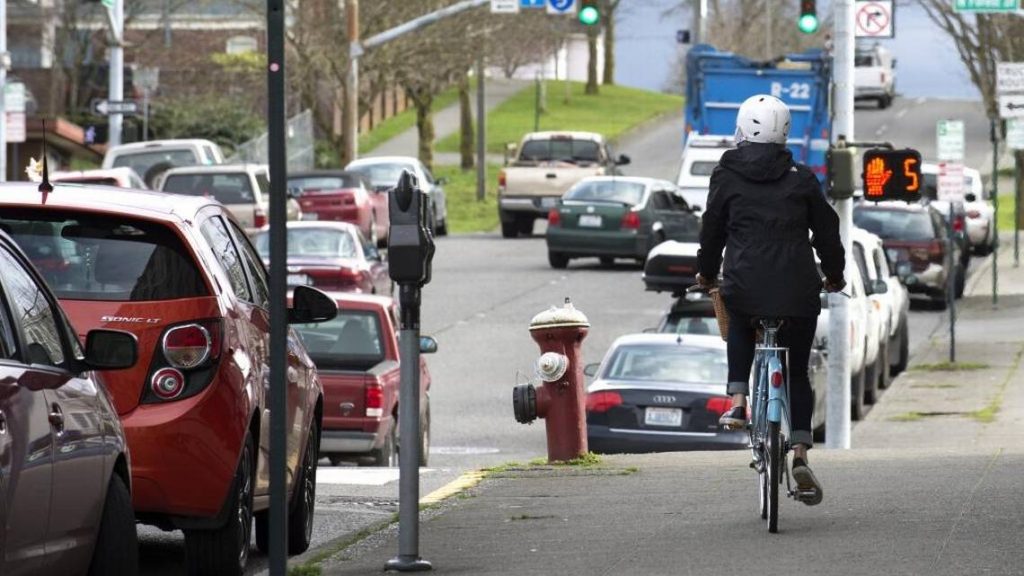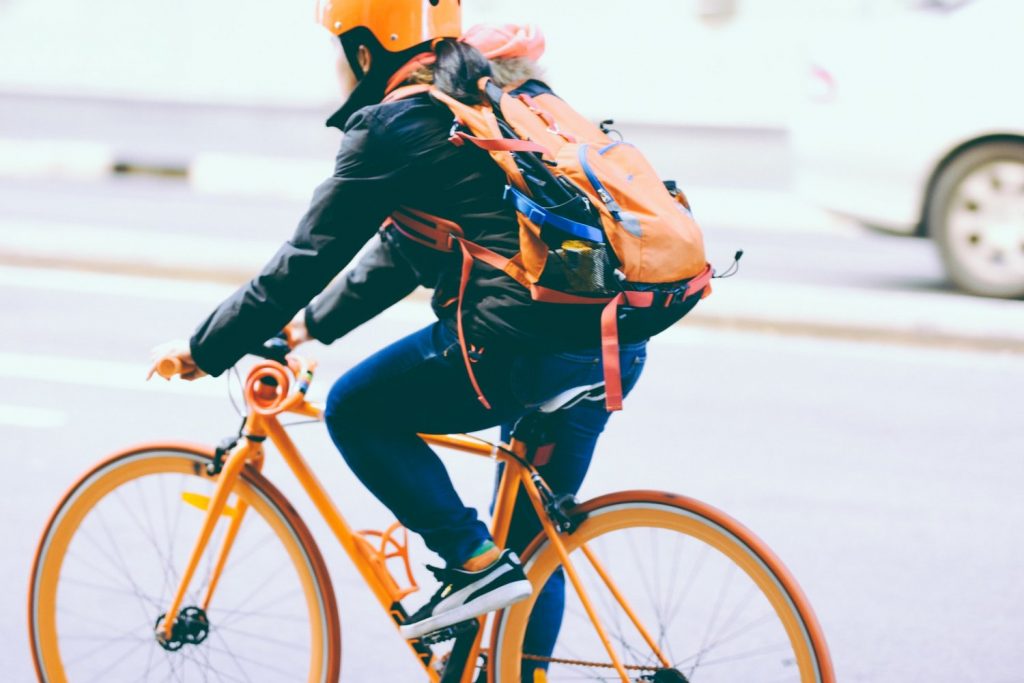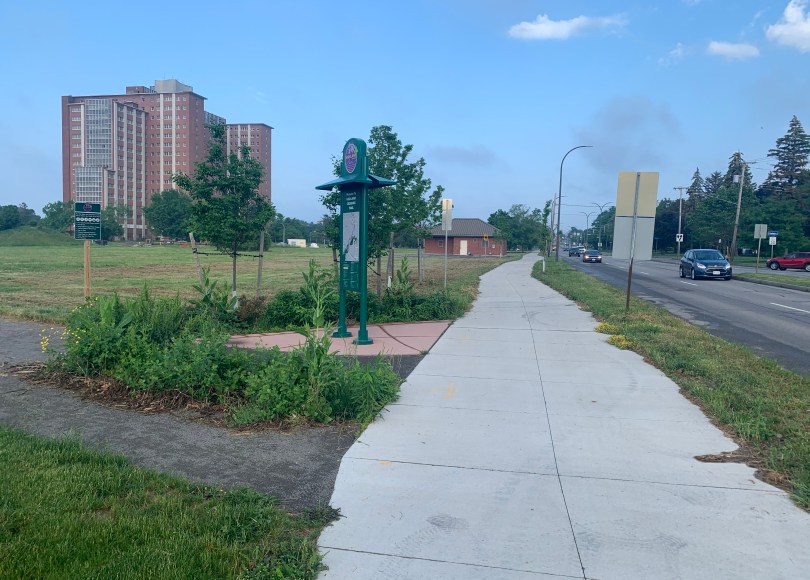Written by Arian Horbovetz and originally published on The Urban Phoenix blog
As early summer finally begins to grace the Northeast, residents of Upstate New York begin their annual euphoric embrace of life without snow, ice, and bitter cold for the first time in 5 months. Like a pauper who suddenly becomes a millionaire, hearty populations of places like Rochester immediately start thinking about what to do with the newfound possibilities created by sunshine and warmth.
For me, this is often the time when people reach out for recommendations on cycling, and specifically, tips on how to commute to work or run errands by bike. Record gas prices have, unsurprisingly, made these requests more frequent and even a bit more urgent than in previous years.
And since I live in a metro that was built to, first and foremost, accommodate the automobile, hesitant first time bike commuters often ask the same question: “is it ok to bike on the sidewalk?”
Thus begins the very multifaceted, multidimensional, and eternally context-driven debate that seems so simple and yet is so very complex. My hope is that this post, once and for all, addresses every perspective on sidewalk cycling and what first time bike-commuters should do, what long-time cyclists should advocate for and what urbanists today should encourage and discourage.

The Debate
In most of the U.S. the law is clear… bikes are vehicles and are thus supposed to be ridden in the road with cars. This oddity that equates a 20-pound bike with a 2-ton automobile in the eyes of the law is actually the result of cycling advocates decades ago who believed (and still do) that bikes and cars should be afforded the same rights.
But obviously, the bike and the car couldn’t be more different mobility solutions with regard to safety and comfort. For the parents who just want to ride with their kids, or for the new rider or new commuter who is understandably shaken by the idea of riding with traffic, the sidewalk is an appealing alternative to biking in the street. And while a majority of municipalities allow bikes on sidewalks, cycling advocates continue to encourage bike riders to ride in the road.
There are several reasons for this, and most of them have to do with driveways and intersections. A large percentage of car/bike crashes happen when a car turns into a cyclist while making a left or right turn, or when a car is pulling into or out of a driveway. For example, let’s say you’re riding your bike northbound on the left hand sidewalk. The road that is parallel to you is 4 lanes wide. You approach an intersection and while you may have the right away across the perpendicular street, a car turning left from the 4 lane road adjacent to you is looking to make their left turn across multiple lanes of oncoming traffic. In the 5-15 seconds that the driver of that car has been waiting for an opening in traffic to turn left, you, the sidewalk cyclist, have ridden up from behind and started to cross the perpendicular street. The driver who finally has space to move in between oncoming traffic turns quickly and a “T-Bone” crash occurs between the driver and the cyclist.
If the cyclist had been riding in the road, they would have been riding with traffic, thus alleviating the sightline issue from the driver’s perspective noted above. Cycling is safer when we eliminate the 90-degree points of conflict between cars and bikes, especially when the bike rider is on the sidewalk.
Also, pedestrians who use sidewalks dislike the presence of faster-moving vehicles like bikes and scooters for reasons of comfort and safety. While I would like to think that sidewalks can be shared space for all of those who navigate their communities without a car, I’ve listened to countless stories of pedestrians who have been struck or rudely surprised by cyclists invading what really should be a “safe space” for those traveling on two feet.
So with regard to a feeling of safety, cyclists are often left without a home. Drivers loath the inconvenience of navigating around road-riding cyclists, while pedestrians on sidewalks see cyclists like cyclists see cars… an uncomfortable point of conflict that needs to be addressed.
Safely Riding The Sidewalk
If riding in the road isn’t for you, here are sure-fire tips to lessen the conflicts that I described above when riding on the sidewalk. To ensure your sidewalk-riding experience is comfortable and responsible, you must be willing to adapt your speed and behavior in acquiescence to pedestrians… and assume drivers don’t see you.
- When riding on the sidewalk and approaching an intersecting road or driveway, approach slowly, first checking to see if a car is approaching via this road or driveway. Next is what I call the “look-back,” which is the sidewalk cycling game changer. Turn your head to the parallel street to see if there is a car turning into the driveway or street you are about to cross. Look for slowing traffic with a turn signal, and if there is any doubt, slow your momentum until you are sure the driver sees you, or stop if you anticipate that the driver does not. Even if you have the right of way, DON’T EVER ASSUME that the driver can see you and navigate the intersection without this step. Use the “look-back” method multiple times as you approach and move across the intersection. If you do this for every intersection, you essentially eliminate one of the most glaring safety risks with sidewalk riding.
- When riding on the sidewalk, give maximum priority to pedestrians by riding in the grass to allow oncoming walkers the entire sidewalk. When approaching pedestrians from behind, slow to 5-10mph or less, kindly announce that you are about to move around them on the left, and ride around them on the grass (if applicable). As a cyclist, it’s important to remember you are a guest on a right-of-way that is reserved for pedestrians. Pedestrian access is a sort of an urbanist “Holy Grail” and one that should not be besmirched.
- Understand that, as a sidewalk rider, you become a pedestrian instead of a vehicle pilot. In other words, let’s say you approach a signaled intersection on bike while riding in the road with traffic. When the light changes green in your direction, you move forward with the flow of traffic. But if you are riding the sidewalk, you may have to press the crosswalk button every time you approach an intersection. If you do not do this, you are taking matters into your own hands. For example, let’s say that you are riding on the sidewalk and the road parallel to you has the green light, but the pedestrian crosswalk signal still says “Don’t Walk” until you press the button to cross the perpendicular street. You decide that the street parallel to the sidewalk you are traversing has the right of way, despite what the pedestrian signal says. If a car turns into you, despite the fact that you didn’t press the button to activate the walk sign, and hits you and a court case is the result, the fact that you did not push the button will likely mean that you are at fault and thus liable for damages.
- I would HIGHLY advise against riding an electric bike on the sidewalk. As most ebikes are capable of speeds upward of 20mph, and weigh far more than the average bike, the threat to pedestrians is greatly magnified and chances that cars navigating cross street won’t see you is heightened. Sidewalk riding should not exceed the typical leisurely pace of 10-12mph.
- Never ride on the sidewalk of a dense urban setting with many storefronts and apartment entrances. Few things make shop and restaurant owners angrier than when their customers have to look both ways before exiting their establishment to avoid being hit by a cyclist.
In Sum
Want to ride on the sidewalk instead of in the road with traffic? That’s fine, most municipalities allow it. And beyond that, I understand it. But if you’re going to ride on the sidewalk, know that you are basically giving up your legal status as a pilot of a vehicle and become a pedestrian, who is legally subject to crosswalk signaling, and who is physically responsible for ensuring that drivers see you when you traverse any intersection.
Also, it’s important to realize why bike advocates like myself encourage riding in the road rather than the sidewalk. We know that there is power in numbers, and that worldwide, the more cyclists there are, the safer the roads are for cyclists. Riding on the sidewalk, however, is seen in much of the cycling community as “giving in” to drivers and yielding the road to automobiles.

As a daily bike commuter, I would strongly encourage you to consider finding alternatives to sidewalk riding. Parallel routes with fewer cars and slower traffic can be game changers, for example. And no matter where you ride, bright lights and a helmet can make you feel a little more in control of your own safety. But if you feel there are places you simply won’t ride in the road, remember the tips from this post. Even I have stretches of road I refuse to traverse on bike, so I slow my speed and take to the concrete, and I refuse to be shameful about it.
For me, I’d rather see someone ride a bike on the sidewalk than not at all. My hope will continue to be that the regular sidewalk rider will eventually transition to the road when they feel more comfortable. But if not, no worries… just take matters of safety and responsibility into your own hands and ride any way you can!






